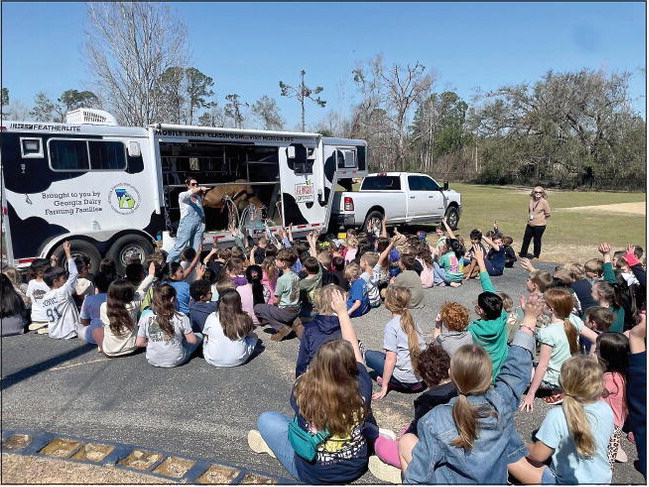Eight BPC Students Published Research in the Georgia Journal of Science
Courtesy of Brewton-Parker College
Brewton-Parker College (BPC) proudly announces that eight of its students have recently been published in the Georgia Journal of Science.
Their research contributions represent the college’s commitment to academic excellence and the advancement of scientific knowledge. The published students, under the guidance of BPC faculty member Dr. Justine Hardy, conducted research across various scientific disciplines. Their work showcases the rigorous academic environment fostered at BPC and the dedication of both students and faculty to scholarly inquiry.
Dr. Justine Hardy, Chair of the Division of Mathematics and Natural Sciences at BPC, praised the students for their dedication to research and innovation. “These publications reflect the high caliber of students at Brewton-Parker College and the quality of mentorship they receive from our faculty. Their work not only enhances our academic reputation but also provides valuable insights for kinesiology, sports science, and human performance.”
The following students conducted research on topics ranging from athletic performance to cognitive function: Noah Gilbert: “The Relationship Between Pitch Clock and Pitching Velocity in Collegiate Baseball Players.” This study evaluated the impact of the new pitch clock rule on baseball pitching velocity. Four pitchers were asked to throw 25-pitch bullpens each in two separate sessions— one without a pitch clock and another with the pitch clock. Velocities were measured using a radar gun and analyzed using a paired t-test. The results revealed no statistical difference in pitching velocity between the two conditions, suggesting that the new pitch clock rule does not affect the velocity of pitches.
Abbey Flowers: “Knee Range of Motion and Running Speed in Collegiate Softball and Baseball Athletics.” The experiment was performed to analyze the relationship between knee joint range of motion (ROM) and sprint speed in collegiate baseball and softball athletes. This study involved 30 participants who underwent knee ROM testing using a goniometer and sprint time assessments over 40 meters. While no significant correlation was found for softball players, a moderate correlation and statistical significance was identified for baseball players. The findings suggest that increased knee ROM positively influences sprint speed in baseball athletes but not softball athletes. The overall result highlights the importance of flexibility training in enhancing performance across these sports.
D. Tate Worrell:
“Does Strength Training Improve Clubhead Speed in Collegiate Golfers?” The study was conducted to determine the impact of a six-week strength training program on golf clubhead speed in collegiate golfers. Eight male golfers were analyzed, measuring their clubhead speed and driving distance before and after the program. The control group maintained their regular training, while the experimental group participated in a structured strength training regimen. Results from a paired t-test showed a significant increase in clubhead speed for those in the weight training group compared to the control group. This indicates that strength training positively affects clubhead speed, providing insights for future training program designs.
Katelyn Ladner:
“Effects of Sugar Intake on Collegiate Students Memory Recall.” This investigation examined how glucose consumption impacts memory recall in college students, focusing on immediate (MWR) and delayed (DR) recall. Conducted at Brewton-Parker College, the study involved 20 participants who consumed either a glucose drink or a placebo. Memory recall was tested before and after supplementation using the SCAT5 concussion protocol. Results showed no significant difference in MWR between the two groups, but a statistically significant improvement in DR was observed with glucose supplementation. The study concluded that while glucose intake did not affect immediate cognitive function, it may have enhanced delayed memory recall in college students.
Bradley Owens:
“Does Vitamin D Supplementation Improve Physical Components in Collegiate Athletes Regarding Strength, Endurance, and Power?” The study evaluated the relationship between vitamin D supplementation and muscle strength, power, and endurance in collegiate athletes at Brewton-Parker College. The study involved 15 participants over six weeks, with assessments conducted through various tests. Participants were divided into experimental and control groups, with the experimental group receiving weekly vitamin D supplementation. Statistical analysis revealed no significant differences in muscle power, strength, or endurance between the supplemented and non-supplemented groups. Consequently, the hypothesis that vitamin D supplementation positively correlates with these muscular attributes is rejected, indicating that it does not enhance performance in collegiate athletes.
Dakota Connell: “Hip Mobility Effects on Bat Speed in Collegiate Baseball and Softball.” This study identified the relationship between hip mobility and bat speed in swing sports. The experiment highlighted the importance of hip range of motion (ROM) for athletes in sports like baseball and softball, where optimal hip ROM is crucial for effective force generation. Twenty-five swing sport athletes were assessed for internal and external hip ROM using a goniometer, and their bat speed was measured with a sensor during swings. Results indicated no significant correlations between most hip ROM measurements and average bat speed, except for a positive relationship between launch hip internal ROM and bat speed. This suggests that while hip ROM generally has a moderate to negligible effect on swing speed, increased internal hip rotation in the launch leg correlates with higher bat speed, providing insights for athlete training and performance optimization.
Matthew Hager: “The Relationship Between Hip and Knee Angles and the Jump Force Produced.” This experiment investigated the relationship between hip and knee angles during athletic activities to determine if a 100° angle maximizes force generation. The study involved seventeen collegiate baseball players performing countermovement jumps while their force output and joint angles were measured. Statistical analysis revealed no significant correlation between hip and knee angles with jump force. The optimal angles found were 90° for the hip and 116° for the knee, leading to the rejection of the hypothesis that a 100° angle would yield maximum force. These findings suggest that athletes should engage in form-specific training to enhance force production by optimizing a smaller hip-over-knee angle ratio.
Chandler Koerner:
“The Relationship Between Ankle, Knee, and Hip Mobility and Lower Limb Force Production in Collegiate Baseball Players.” This study looked at force production and its relationship with mobility, stability, and athletic performance by measuring the range of motion (ROM) in the ankle, knee, and hip joints. This study assessed ROM of 17 uninjured collegiate baseball athletes during a counter movement jump (CMJ) and evaluated lower-limb stability using the Y Balance Test. Force production was measured through CMJs on a force plate. The findings revealed no significant correlations between force production and ankle dorsiflexion, ankle plantarflexion, hip flexion, hip extension, or Y-Balance stability scores. However, a significant positive relationship was found between knee flexion and jump force production, indicating that increased knee flexion correlates with greater force production during jumps. The results suggest that enhancing knee flexion may benefit athletic performance.
The Georgia Journal of Science is a peer-reviewed academic journal published by the Georgia Academy of Science. The journal serves as a platform for researchers, educators, and students in Georgia to share their findings with the broader scientific community. The contributions of eight BPC students represent a significant achievement that highlights the college’s commitment to rigorous academics and advanced, hands-on scientific research, preparing students for future academic and professional success.
Visit the Georgia Journal of Science at http://www. gaacademy. org/ journal. html › GA Journal of Science to find student publications.
For more information about Brewton-Parker College’s Division of Mathematics and Natural Sciences, visit https://bpc.edu/ divisions/ mathematicsand- natural-sciences/.







